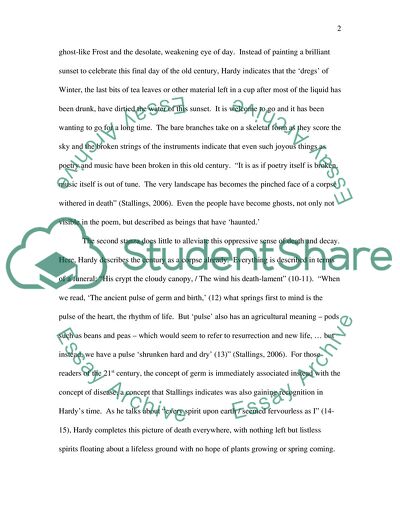
- Home
- Free Samples
- Premium Essays
- Editing Services
- Extra Tools
- Essay Writing Help
- About Us
- Studentshare
- Subjects
- Miscellaneous
- Poetry Analysis Paper discussing the theme in Thomas Hardy's The Darkling Thrush
Poetry Analysis Paper discussing the theme in Thomas Hardy's The Darkling Thrush - Essay Example

- Subject: Miscellaneous
- Type: Essay
- Level: Masters
- Pages: 4 (1000 words)
- Downloads: 0
- Author: zmurazik
Extract of sample "Poetry Analysis Paper discussing the theme in Thomas Hardy's The Darkling Thrush"
Although Thomas Hardy’s poem “The Darkling Thrush” seems at first to be very dark and forbidding, the note of hope at the end denies this impression and seems instead brighter because of the gloom that has preceded it, making it seem as though Hardy had visions of a better future when he wrote this poem. The first stanza contains a great deal of dark imagery that bring to mind the conception of death. The author introduces himself as leaning on a gate, immediately introducing the concept of weakness or fatigue even as he brings in the concept of a change occurring, he is about to pass into or out of something, which is signified by the gate itself.
The concern of weakness is reinforced as he brings in images of death in the ghost-like Frost and the desolate, weakening eye of day. Instead of painting a brilliant sunset to celebrate this final day of the old century, Hardy indicates that the ‘dregs’ of Winter, the last bits of tea leaves or other material left in a cup after most of the liquid has been drunk, have dirtied the water of this sunset. It is welcome to go and it has been wanting to go for a long time. The bare branches take on a skeletal form as they score the sky and the broken strings of the instruments indicate that even such joyous things as poetry and music have been broken in this old century.
“It is as if poetry itself is broken, music itself is out of tune. The very landscape has becomes the pinched face of a corpse withered in death” (Stallings, 2006). Even the people have become ghosts, not only not visible in the poem, but described as beings that have ‘haunted.’ The second stanza does little to alleviate this oppressive sense of death and decay. Here, Hardy describes the century as a corpse already. Everything is described in terms of a funeral: “His crypt the cloudy canopy, / The wind his death-lament” (10-11).
“When we
...Download file to see next pages Read MoreCHECK THESE SAMPLES OF Poetry Analysis Paper discussing the theme in Thomas Hardy's The Darkling Thrush
Thomas Hardy - a Novelist with a Poetic Vision
The Oxen and The Darkling Thrush
Religious Skepticism in the Poetry of Thomas Hardy
Poetry Explication on Sir Thomas Wyatt the Poem Farewell Love
Tone, Rhyme, and Irony in Thomas Hardy's the workbox
Hardy: A Poet of Awkward Innocence
Thomas Hardy as a Novelist with a Poetic Vision
Ode to a Nightingale by John Keats and The Darkling Thrush by Thomas Hardy

- TERMS & CONDITIONS
- PRIVACY POLICY
- COOKIES POLICY